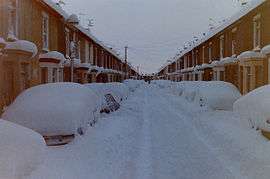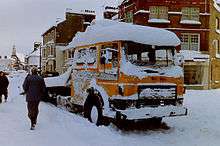1987 United Kingdom and Ireland cold wave
The January 1987 snowfall was a very heavy lake-effect type snow event that affected the United Kingdom, mainly the areas of East Anglia, South-East England and London between 11 and 14 January[2] and was the heaviest snowfall to fall in that part of the United Kingdom since the winter of 1981/82. Over 50 centimetres (20 in) of snow fell in South East England, with some locations reporting snowfall at 75 centimetres (30 in).[3] Ireland was also affected by the cold wave, reporting more than 10 centimetres (3.9 in) in some areas.
 Snow-covered street in Sheerness | |
| Formed | 7 January 1987 |
|---|---|
| Dissipated | 20 January 1987 |
| Lowest temperature | −23.3 °C (−9.9 °F) (13 January 1987, Caldecott, Rutland[1]) |
| Areas affected | United Kingdom and Ireland |
United Kingdom

During the cold wave, more than 50 centimetres (20 in) of snow fell in parts of Kent, Essex, London and Surrey, and the North Downs reported more than 75 centimetres (30 in)Parts of West Cornwall also had heavy falls.[2] Several towns were cut off due to the heavy snowfall including the Isle of Sheppey which needed airlifts during the height of the storm.
This was due to a high pressure system over Siberia that moved into Scandinavia which in turn dragged a strong easterly airflow and brought very cold temperatures across Europe and the United Kingdom. A low pressure system over Italy caused the airflow to drag the very cold air from Siberia to Western Europe and picked up further moisture from the North Sea which produced the heavy snowfall. This caused serious disruption of transport in the area including the cancellation of many train services and the closure of many roads and railway lines. Motoring organisations had to deal with more than 4000 car breakdowns and 500 schools were forced to close. The extreme cold even affected the chiming hammer of Big Ben and at Southend-on-Sea the sea froze over.
The cold spell lasted from the 7th to the 20th, and was probably the most intense of the twentieth century. Temperatures stayed well below freezing on many days. On the 12th, maximum temperatures were between −6 °C (21 °F) and −8 °C (18 °F) over much of England, with −9.1 °C (15.6 °F) the daily maximum at Warlingham.[2] The lowest overnight temperature of −23.3 °C (−9.9 °F) was recorded at Caldecott, Rutland, making it the coldest recorded temperature in the East Midlands.[1]
Ireland
In Ireland, the amount of snowfall was far less pronounced, but had a similar weather pattern to the United Kingdom. The amount of snowfall was greater in areas further inland than coastal areas. Around 12 centimetres (4.7 in) of snow was recorded in the Irish Midlands and the East of Ireland, with some places recording snowfall as high as 19 centimetres (7.5 in) in the east.
At Roches Point 12 centimetres (4.7 in) of snow was reported, and is the highest depth of snow since snow observations began at Roches Point since 1961. As well as the snow record, the temperature dropped down to −7.2 °C (19.0 °F) on 13 January, and is the coldest temperature recorded at Roches Point since record observations began in 1867. It's also likely that this figure marks the coldest temperature during the cold wave.[4]
See also
| Wikimedia Commons has media related to Snowfall of January 1987 in England. |
References
- "Top ten coldest recorded temperatures in the UK". Met Office. 16 October 2012. Retrieved 16 April 2018.
- Eden, Philip (2008). Great British Weather Disasters. Continuum. pp. 313–314. ISBN 978-0-8264-7621-0.
- "1987 January". Tonbridge Weather Notes. May 2006. Archived from the original on 28 August 2006. Retrieved 19 February 2019.
- "The Snowfall of 1987" (PDF). Met Éireann. Archived from the original (PDF) on 22 February 2011. Retrieved 16 April 2018.
External links
- "Rainham Kent Snow Photos 1987". Rainham History.
- "January 1987". Netweather Forum. 16 November 2006.
- Eden, Philip (2 February 2009). "Snow Britain: Wrong kind of snow strikes again". The Daily Telegraph.
- ludensian (28 March 2008). "Thames News: Big Freeze, January 1987". YouTube.
- Woodcock, Andy (January 2003). "Record Cold Spell of 1987: How It All Started". The Weather Outlook.
- Baldwin, David (1 April 2008). "BBC1 Hourly News Summary 13 January 1987". YouTube.
- Harley, T. A. "1987". The British Weather. Archived from the original on 16 October 2008.